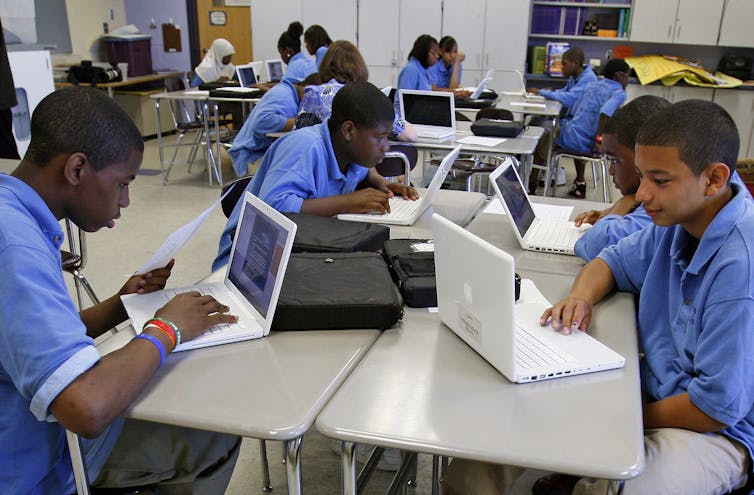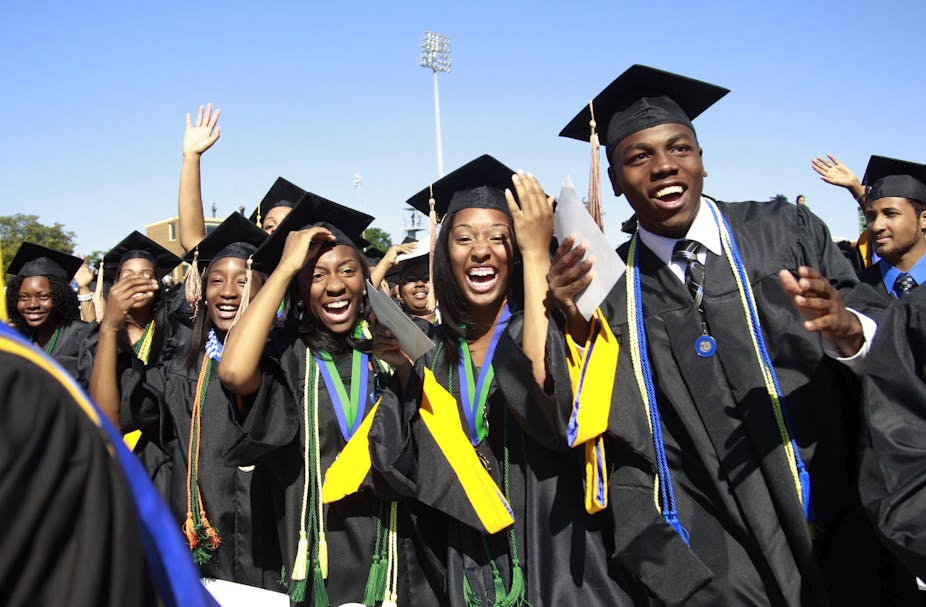A recent report by The Education Trust, a nonprofit working on educational justice, reveals that while there has been an improvement in graduation rates at four-year public institutions for all students, the improvement is smaller for black students.
According to the report, the gaps in graduation rates between black and white students have either stayed the same or did not show the same increase as they did for white students. The report shows that even among institutions that improved overall graduation rates from 2003 to 2013, more than half of them (53 percent) did not make the same gains for black students as they did for white students.
This begs the question: are black students losing ground in graduation rates?
As a researcher who has been studying the psychological factors that impact black students’ academic achievement, I find that getting a handle on black students’ graduation rates reminds me of the saying “lies, damned lies, and statistics,” because carefully selected statistics can tell very different stories.
The point is that the statistics being shared about black students’ graduation rates present a narrow and somewhat incomplete understanding of the actual progress black students have made.
Income, college costs and graduation rates
It is true that graduation rates for black students at four-year public schools have been dismally low for many years.
Between 2003 and 2013 the graduation rate for black students increased only marginally – from 38.2 percent to 40.3 percent, showing a change of only 2.1 percent. Now compare these numbers with white students, whose graduation rates increased from 55.4 percent to 60.7 percent – an increase of 5.3 percent during the same period.
Overall, the graduation gap between black and white students increased from 17.2 percent in 2003 to 20.4 percent in 2013.
One reason for the increased gap is likely related to the economy.
Black families have been the ones to be hit the hardest during the the Great Recession that started in the late 2000s. The median black family income was US$44,000 in 2000, but had decreased to $39,715 by 2010, compared to $63,941 for whites.
In 2010 the net worth of black families was a paltry $4,900 compared to $97,000 for whites. At the same time, as a result of budget cuts in state funding, tuition at public universities increased. Between 2005 and 2015, tuition at public universities increased by 73 percent.

Unsurprisingly, studies show how college graduation rates of low-income students also dropped around the same time. For example, a report – Indicators of Higher Education Equity in the United States – from the University of Pennsylvania’s Alliance for Higher Education and Democracy and the Pell Institute for the Study of Opportunity in Higher Education showed that in 2013, 77 percent of adults from families in the top 25 percent of incomes graduated from college, compared to only 40 percent in 1970. In contrast, only 9 percent of adults from families in the bottom 25 percent of incomes graduated in 2013 compared to 6 percent in 1970.
Given the link between income, wealth and college graduation, it is probably no coincidence that the growing graduation gaps among black and white students between 2003 and 2013 overlapped with the decrease in black family income and wealth between 2000 and 2010.
What’s missing in the data
However, it would be a mistake to frame the issue only in economic terms. As is often the case in research, the way research is conducted can lead to faulty or incomplete conclusions.
Research results can often mask different outcomes for different groups of students, especially for black students. In my own teaching and research, I have discussed the importance for researchers to always disaggregate data by race and ethnicity because important group differences can sometimes be masked.
For example, data from this latest report by The Education Trust focuses on four-year public schools. It does not consider private schools, which include some of the highest-ranking schools (and thus highest-achieving black students) in the country.
Black student graduation rates at private schools are considerably higher. Data published in April 2016 in the Journal of Blacks in Higher Education, which provides racial statistics on an institution-by-institution basis, show that at highly selective colleges and universities, black student graduation rates range from 88 percent (Notre Dame University) to 96 percent (Harvard University).

Even among the selective colleges, such as the University of California at Berkeley, the University of North Carolina at Chapel Hill and the University of Michigan, which show lower black student graduation rates, the picture is not that bleak. At some of these colleges, black student graduation rates range from 70 percent to 75 percent, which still puts them far ahead of the average for four-year colleges and universities.
It is also important to note that the graduation rate gap between black and white students is much smaller at prestigious colleges and universities. For example, the graduation rate gap at Washington University is 91 percent to 90 percent in favor of white students, at Yale University 97 percent to 94 percent and at Johns Hopkins University 89 percent to 86 percent.
Once again, data from a small number of highly selective colleges and universities show that the black student graduation rate equals or exceeds white students (e.g., California Institute of Technology, Wellesley College, Wake Forest University) or is no more than 5 percent lower than white students (e.g., Stanford, Brown and Columbia universities).
This, of course, does not negate the general observation that black students’ graduation rates at four-year public schools have increased only incrementally and at a lower rate than white students’ graduation rates. However, it is important to take into account the complete picture as well.
Data that focus exclusively on the lower graduation rates of black students are part of a deficit narrative that does not acknowledge there are certain segments of black students who are graduating and doing well.
The full picture
Finally, the researcher in me must point out one very important methodological issue related to interpreting black students’ graduation rates.
In a recent article my colleagues and I point out the difficulties in understanding issues of access and opportunity among black students because often studies do not take into account the diversity and heterogeneity within the black population. Specifically, the federal government and colleges and universities do not typically disaggregate data on race, nativity and ethnicity.
This is very important because it is well-documented that black immigrants (e.g., Africans and Afro-Caribbeans) are overrepresented among black students at U.S. four-year colleges and universities, especially at highly selective schools. It has been estimated that 40 percent of the black student population at highly selective schools consists of black immigrants.
It is possible that the graduation rates of African and Afro-Caribbean students are much higher in all higher education institutions (i.e., public and private), but given the current data, we do not know. This matters because it would focus the narrative of graduation rates on better understanding the challenges facing African-American students, which, as mentioned earlier, could be linked to socioeconomic status.
There is clearly a black-white graduation rate gap that exists for a segment of black college students. And that is a matter of concern. Overall, black graduation rates have increased at a slower rate than white students. These can likely be explained, in part, by changes and instability in the economy that have decreased the wealth and median income of black families, thus making it more difficult to pay for college. Other reasons are more institutional.
However, it is also important to remember that the picture is not entirely bleak. We should not lose sight of the fact that there are also black college students who are doing very well and graduating.
At many four-year public schools, much work to support black students still needs to be done. But, let’s remember, statistics can tell multiple stories.

